Intel Xeon E Six-Core Review: E-2186G, E-2176G, E-2146G, and E-2136 Tested
by Ian Cutress on November 5, 2018 12:00 PM EST- Posted in
- CPUs
- Intel
- Xeon
- Enterprise CPUs
- Xeon E
CPU Performance: System Tests
Our System Test section focuses significantly on real-world testing, user experience, with a slight nod to throughput. In this section we cover application loading time, image processing, simple scientific physics, emulation, neural simulation, optimized compute, and 3D model development, with a combination of readily available and custom software. For some of these tests, the bigger suites such as PCMark do cover them (we publish those values in our office section), although multiple perspectives is always beneficial. In all our tests we will explain in-depth what is being tested, and how we are testing.
All of our benchmark results can also be found in our benchmark engine, Bench.
Application Load: GIMP 2.10.4
One of the most important aspects about user experience and workflow is how fast does a system respond. A good test of this is to see how long it takes for an application to load. Most applications these days, when on an SSD, load fairly instantly, however some office tools require asset pre-loading before being available. Most operating systems employ caching as well, so when certain software is loaded repeatedly (web browser, office tools), then can be initialized much quicker.
In our last suite, we tested how long it took to load a large PDF in Adobe Acrobat. Unfortunately this test was a nightmare to program for, and didn’t transfer over to Win10 RS3 easily. In the meantime we discovered an application that can automate this test, and we put it up against GIMP, a popular free open-source online photo editing tool, and the major alternative to Adobe Photoshop. We set it to load a large 50MB design template, and perform the load 10 times with 10 seconds in-between each. Due to caching, the first 3-5 results are often slower than the rest, and time to cache can be inconsistent, we take the average of the last five results to show CPU processing on cached loading.

FCAT: Image Processing
The FCAT software was developed to help detect microstuttering, dropped frames, and run frames in graphics benchmarks when two accelerators were paired together to render a scene. Due to game engines and graphics drivers, not all GPU combinations performed ideally, which led to this software fixing colors to each rendered frame and dynamic raw recording of the data using a video capture device.
The FCAT software takes that recorded video, which in our case is 90 seconds of a 1440p run of Rise of the Tomb Raider, and processes that color data into frame time data so the system can plot an ‘observed’ frame rate, and correlate that to the power consumption of the accelerators. This test, by virtue of how quickly it was put together, is single threaded. We run the process and report the time to completion.
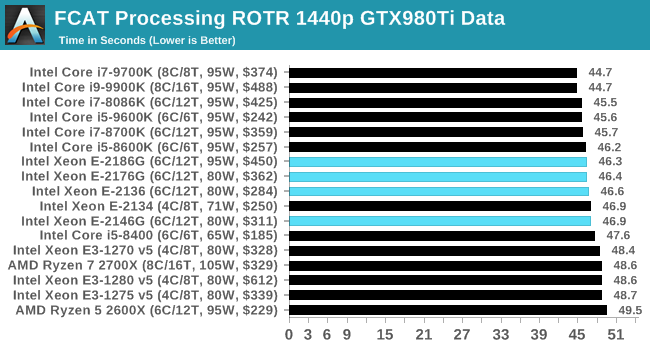
3D Particle Movement v2.1: Brownian Motion
Our 3DPM test is a custom built benchmark designed to simulate six different particle movement algorithms of points in a 3D space. The algorithms were developed as part of my PhD., and while ultimately perform best on a GPU, provide a good idea on how instruction streams are interpreted by different microarchitectures.
A key part of the algorithms is the random number generation – we use relatively fast generation which ends up implementing dependency chains in the code. The upgrade over the naïve first version of this code solved for false sharing in the caches, a major bottleneck. We are also looking at AVX2 and AVX512 versions of this benchmark for future reviews.
For this test, we run a stock particle set over the six algorithms for 20 seconds apiece, with 10 second pauses, and report the total rate of particle movement, in millions of operations (movements) per second. We have a non-AVX version and an AVX version, with the latter implementing AVX512 and AVX2 where possible.
3DPM v2.1 can be downloaded from our server: 3DPMv2.1.rar (13.0 MB)
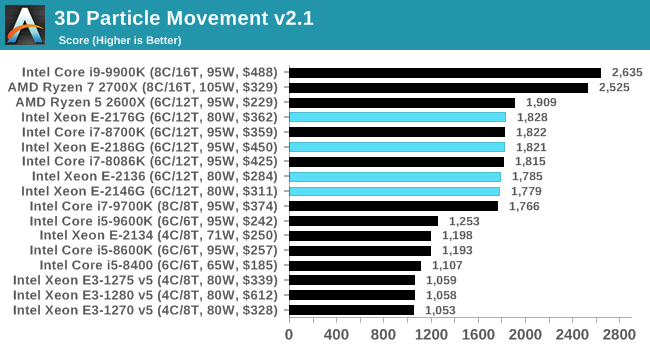
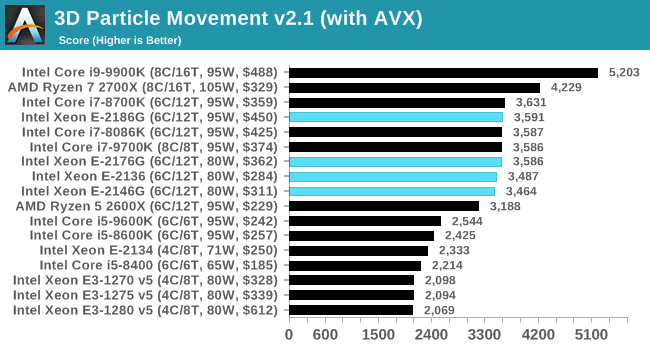
Dolphin 5.0: Console Emulation
One of the popular requested tests in our suite is to do with console emulation. Being able to pick up a game from an older system and run it as expected depends on the overhead of the emulator: it takes a significantly more powerful x86 system to be able to accurately emulate an older non-x86 console, especially if code for that console was made to abuse certain physical bugs in the hardware.
For our test, we use the popular Dolphin emulation software, and run a compute project through it to determine how close to a standard console system our processors can emulate. In this test, a Nintendo Wii would take around 1050 seconds.
The latest version of Dolphin can be downloaded from https://dolphin-emu.org/
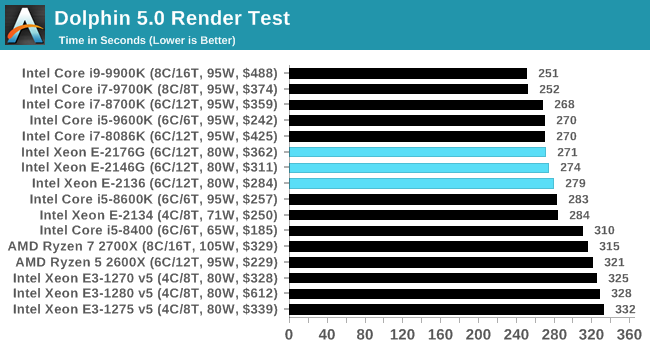
DigiCortex 1.20: Sea Slug Brain Simulation
This benchmark was originally designed for simulation and visualization of neuron and synapse activity, as is commonly found in the brain. The software comes with a variety of benchmark modes, and we take the small benchmark which runs a 32k neuron / 1.8B synapse simulation, equivalent to a Sea Slug.
Example of a 2.1B neuron simulation
We report the results as the ability to simulate the data as a fraction of real-time, so anything above a ‘one’ is suitable for real-time work. Out of the two modes, a ‘non-firing’ mode which is DRAM heavy and a ‘firing’ mode which has CPU work, we choose the latter. Despite this, the benchmark is still affected by DRAM speed a fair amount.
DigiCortex can be downloaded from http://www.digicortex.net/
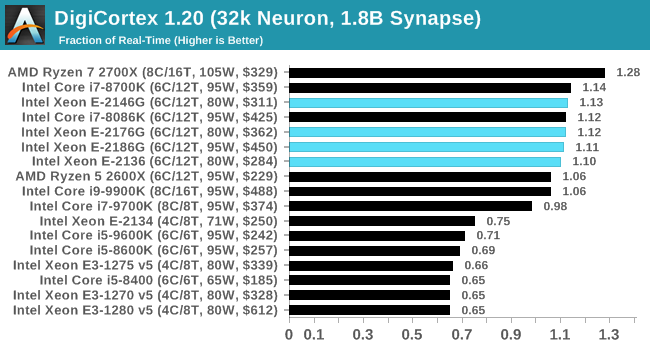
y-Cruncher v0.7.6: Microarchitecture Optimized Compute
I’ve known about y-Cruncher for a while, as a tool to help compute various mathematical constants, but it wasn’t until I began talking with its developer, Alex Yee, a researcher from NWU and now software optimization developer, that I realized that he has optimized the software like crazy to get the best performance. Naturally, any simulation that can take 20+ days can benefit from a 1% performance increase! Alex started y-cruncher as a high-school project, but it is now at a state where Alex is keeping it up to date to take advantage of the latest instruction sets before they are even made available in hardware.
For our test we run y-cruncher v0.7.6 through all the different optimized variants of the binary, single threaded and multi-threaded, including the AVX-512 optimized binaries. The test is to calculate 250m digits of Pi, and we use the single threaded and multi-threaded versions of this test.
Users can download y-cruncher from Alex’s website: http://www.numberworld.org/y-cruncher/
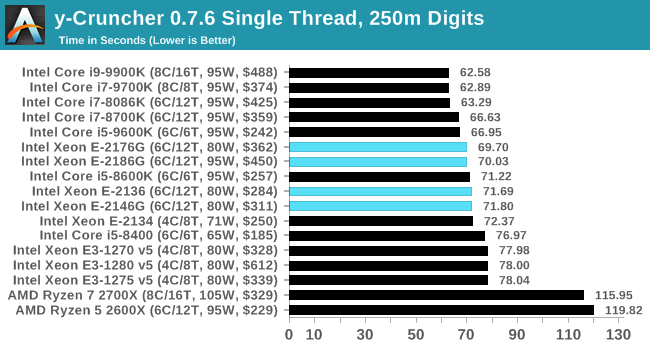
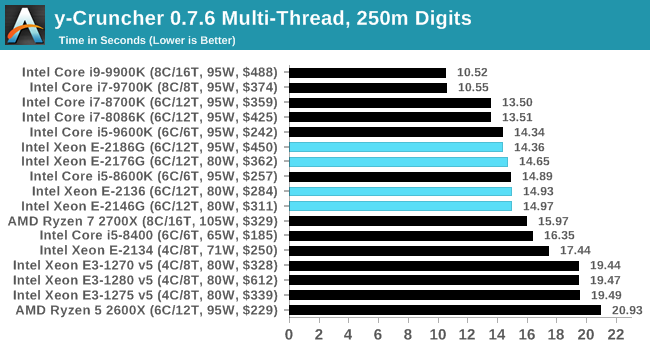
Agisoft Photoscan 1.3.3: 2D Image to 3D Model Conversion
One of the ISVs that we have worked with for a number of years is Agisoft, who develop software called PhotoScan that transforms a number of 2D images into a 3D model. This is an important tool in model development and archiving, and relies on a number of single threaded and multi-threaded algorithms to go from one side of the computation to the other.
In our test, we take v1.3.3 of the software with a good sized data set of 84 x 18 megapixel photos and push it through a reasonably fast variant of the algorithms, but is still more stringent than our 2017 test. We report the total time to complete the process.
Agisoft’s Photoscan website can be found here: http://www.agisoft.com/
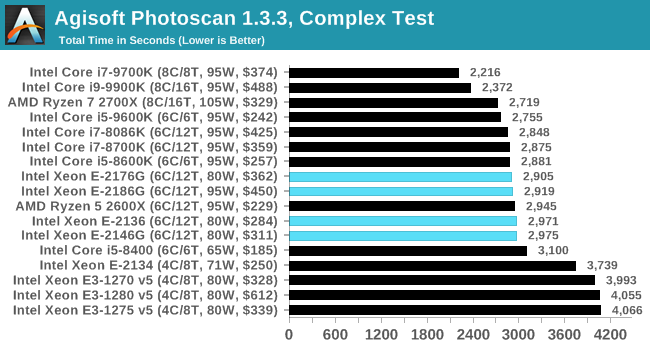


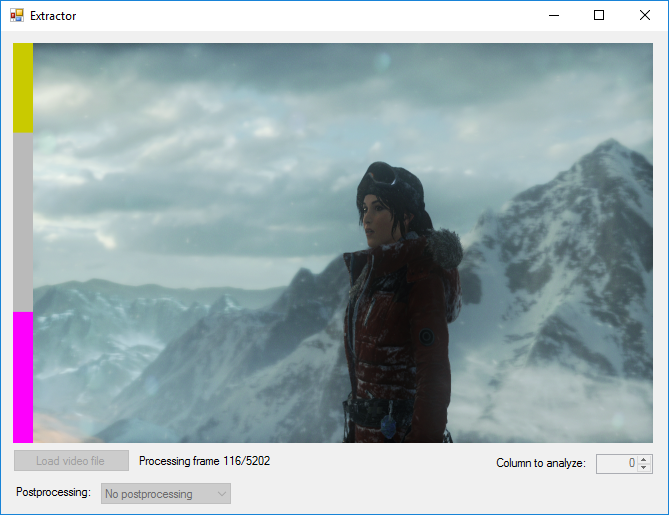










48 Comments
View All Comments
GTVic - Monday, November 5, 2018 - link
I'm wondering what is the status on the W-Series. Seems like no update/launches for over 1 year?CallumS - Monday, November 5, 2018 - link
These look great for SMB finance/inventory management/ERP applications where low latency and high single thread performance is often most beneficial. Or where software is licensed per core. Particularly if they are available within servers with OK remote management functionality at decent price points. I'd love to be able to recommend 3 or 4 of them, and the presumably upcoming 8 core configuration when it is are available, in 1U servers to SMBs rather than Xeon-SP configurations.The Intel Xeon-SP configurations are obviously still going to be the best performing and value for a lot of large enterprise/scale workloads but for smaller organisations and applications only used by under a 100 users, having the simplicity (i.e. no NUMA configuration/consideration requirements) and the performance benefits of a leaner configuration would be great. Plus, having 3 or 4 identical servers with SSD drives in RAID1 could dramatically simplify and improve a lot of local hardware related DR capabilities for organisations with moderate budgets and requirements (essentially an unplug of production SSD drives and move to another/test server).
From a market competition perspective, unfortunately it doesn't look like there is any other decent options for entry level server usage at this price at the moment. The AMD EPYC platform and CPUs are too expensive and at too lower clock speeds for a lot of business applications requiring quick response times/low latency and or licensing per core. And while AMD Ryzen CPUs are great for desktops, particularly where a dedicated GPU was already going to be required, this is actually one area where the Intel solutions can often end up cheaper and better when factoring platform costs - while also having far better support and availability. Therefore, it's really just Intel competing with themselves at the moment and enticing businesses to upgrade/invest. While not hopeful, it would be great if AMD and partners could change this.
Given that an 8700k in one of my desktops is already quicker than a lot of the 12 to 16 core Intel Xeon-SP configurations that we've also used, even for heavy load tests, due to frequency, latency, and IPC benefits, I'm really looking forward to these CPUs, and the 8 core version, hitting the market. Just the saving in per core licensing costs would probably make it cheaper to buy new servers with these CPUs than to configure new VMs on existing Xeon-SP servers for new setups.
Cooe - Tuesday, November 6, 2018 - link
Uhh... You seem to have entirely forgotten that X399 & Ryzen Threadripper exist. Plenty good single-core performance, but absolutely barnstorming multi-core for the price, ECC support, AND 64x PCIe 3.0 lanes.CallumS - Tuesday, November 6, 2018 - link
Agreed about Ryzen Threadripper CPUs being great for multi-threaded workloads and also having pretty good single core performance. I didn't forget, it's what will likely be in my next workstation, I just didn't go into that detail for the purpose of brevity.For production server purposes, atleast a basic remote management interface and support from the major vendors is generally required, though. If we could get a Ryzen Threadripper 2950X or equivalent EPYC CPU with similar frequencies in a 1RU chasis from a major vendor with decent support and management interfaces at a good price, we'd be all over it. Perhaps with the new Zen 2 EPYC CPUs about to be announced, AMD will offer something like it. I certainly hope so.
Spunjji - Tuesday, November 6, 2018 - link
It has nothing to do with what AMD are offering, unfortunately, and everything to do with what system integrators are prepared to put out there. As long as Intel is filling their pockets with plenty of MDF then I wouldn't expect to see anything soon. Hell, HP even took the iLO out of their MicroServer when they switched back to using AMD CPUs because "reasons".CallumS - Tuesday, November 6, 2018 - link
I think that it's far more likely to be a combination. System integrators still require support from manufacturers/vendors for the products/solutions that they are selling. And both AMD and Intel definitely put in mechanisms/differences to protect product lines/profit. It's not like the major vendors aren't selling EPYC systems now. A new EPYC SKU by AMD with 2950X like performance would in itself provide us with the option for a higher frequency server/EPYC CPU. Given the TDP of the Epyc 7601, it should be quite easy and practical to do from engineering and manufacturing perspectives. Or, alternatively, it should be easy enough for AMD to provide capabilities for, and to encourage, board partners to release 'server' orientated Threadripper boards. Either of which I'd love to see - but would still much prefer higher frequency EPYC SKUs due to memory and platform advantages - particularly with major system integrators already having validated EPYC server platforms.Dusk_Star - Monday, November 5, 2018 - link
Corsair Ballistix4x4GB
DDR4-2666
I feel like this should be *Crucial Ballistix* to match the rest of the "Test Setup" table.
watersb - Tuesday, November 6, 2018 - link
Awesome review, many thanks.I usually build my systems with ECC DRAM, whenever possible, but that has become a huge pain point over the past few generations.
I prefer to hear the news on these parts from AnandTech. ServeTheHome is fantastic, but nothing but $10,000+ systems gets a bit discouraging.
mkaibear - Tuesday, November 6, 2018 - link
Can I just say how much the header text (EEEEEEEE) made me laugh?Not sure why, think it just appealed to my inner surrealist.
Cheers!
CyrIng - Thursday, November 8, 2018 - link
Nice review and thanks for the Chromium results but those are professional processors which to my pov will also be employed in Linux/BSD/database/backend frameworks and so on where games don't really matter.For example, x86 and arm cross compilations such as buildroot would be great to read.
As an engineer Windows is out of the scope